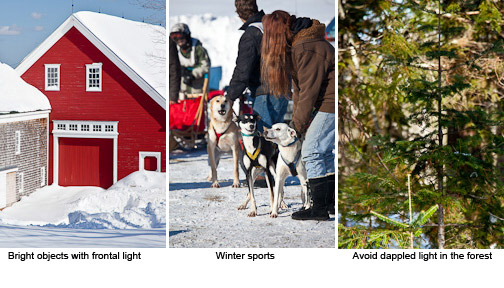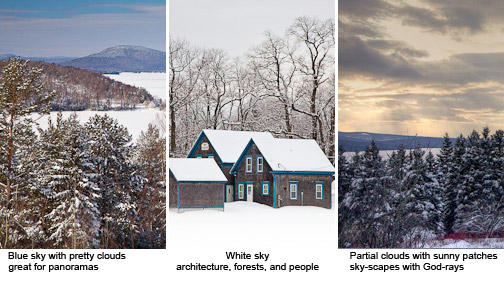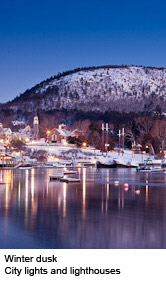The Many Types of Light in Winter
On last week’s trip to Maine I experienced the full range of challenging winter photo situations. With that experience in mind, I thought I’d write about the various types of light you might encounter on a winter day, and what looks best in each lighting situation. Sunrise and sunset feature colorful clouds, magenta snow, and […]

On last week’s trip to Maine I experienced the full range of challenging winter photo situations. With that experience in mind, I thought I’d write about the various types of light you might encounter on a winter day, and what looks best in each lighting situation.
Sunrise and sunset feature colorful clouds, magenta snow, and soft light.
- Look toward the sun and shoot the sky with reflections in water. Silhouettes are good, but no major part of a picture should be featureless black.
- Look away from the sun and shoot landscapes with alpenglow, warm golden light, and reflections in windows.
- With the sun on your left or right, show a colorful sky graduating from bright to dark. On the ground, buildings may be brightly lit on one side and dark on the other.
These pictures show the directions of light at sunrise and sunset:
Sunny winter daylight has white snow, blue sky, and severe shadows.
- With the sun at your back, photograph brightly-colored buildings accented by snow. Try to avoid including the shady sides of the buildings as well as the sunlit side.
- Take pictures of broad panoramas with lots of sky. Harbors, open land, and sunlit city skylines usually look good in bright winter light.
- Shoot seascapes, flowing rivers, or any scene with water reflecting the blue sky.
- Capture winter sports in brilliant light so your camera can stop the action without blur.
- Avoid forest scenes because the dappled light and harsh shadows create visual chaos.
These pictures show the good and bad things to shoot on a sunny day:
Clouds decorate blue skies and soften the harsh shadows that ruin contrasty pictures.
- Capture broad panoramas with pretty, decorative clouds. If the clouds are moving, wait for their shadows to spotlight beautiful things or hide the ugly ones. If the sun is on your right or left, clouds and landscapes look especially appealing.
- Shoot crepuscular rays (God-rays) over land or water and sky-scapes with dramatic clouds.
- On days with a bright white sky, photograph softly-lit forest scenes and details of nature.
- Cloudy days are good for buildings, close-ups of architecture, and canyons or city streets which are too stark in full sun.
- Avoid panoramas that include a lot of white sky with a white landscape. There just isn’t much to look at.
These pictures show some cloudy pictures to shoot:
Snow flurries soften the focus.
- To avoid making everything look washed out, pick subjects with strong color. The snowflakes will also stand out against dark backgrounds.
- A fast shutter speed makes snowflakes look like dots and a slow shutter speed makes them look like dashes. Turn on your flash to make the flakes show up best.
At dusk the light is very blue.
- Capture city lights at dusk with reflections in water for a knock-out image. If you shoot at F-16 or higher, the lights will look like twinkling stars.
- Shoot the beam from a lighthouse beacon with a long exposure. They flash at regular intervals so you can time your shot to include them.
The last picture shows city lights at dusk:
Of course, there are exceptions to rules and new cameras have better abilities to handle photographic challenges.
All photos © Susan Cole Kelly.
Susan Cole Kelly is a compulsive shutterbug based in Boston and downeast Maine. You can see more of her work at http://susancolekelly.photoshelter.com/


